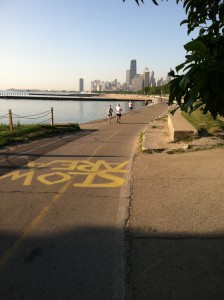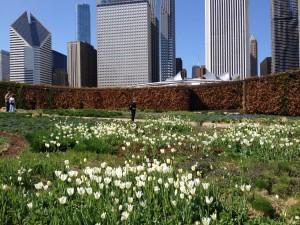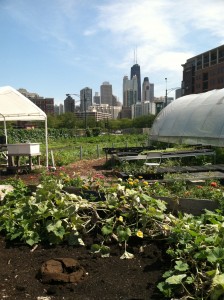I spent my summer in Chicago. As far as national parks and vast green space goes, the city isn’t the best reference. However, there is a surprising amount of effort out out by the city residents to keep a strong environmental connection. Chicago is one of the most active cities during the summers. The winters are a whole different story… I was a nanny to a 6 month old so we spent a lot of time outdoors on walking trails and in parks throughout the city. Millennium Park is my all time favorite, although is not exactly a “natural” park. Lincoln Park a little bit outside of downtown is full of life and green space. Although Chicago has been ranked third lowest in the country for amount of park space (www.chicagomag.com/Chicago-Magazine/June-2007/How-We-Compare-Green-Space/), I think it does a pretty good job of being “green.” The city has extremely efficient and safe bike lanes all over the streets. The lake front trail has both pedestrian and cyclist trails which are both used all the time. Something I have noticed after living in Chicago and then Austin and biking around the two cities is that Austin’s bike lanes are actually more dangerous to ride on than the ones in Chicago. Chicago also has a citywide ordinance that “increases penalties for motorists who endanger cyclists or block bike lanes” (Pucher and Buehler 312). Austin has penalties for that as well, so I think the difference in safety has to do with the awareness of drivers. My first impression was that the bigger city would be more dangerous, but I think that because the cars are so close together and the roads are so busy, they force drivers to drive slower and be more aware. In Chicago, cyclists aren’t in as much danger as they are in Austin where the drivers aren’t as aware of the things happening around them. Crammed city streets are surprisingly comforting after a year of Austin drivers! Although a lot of people do still have cars, a huge amount of Chicago residents use public transportation, which is a really good way to limit car exhaust and oil consumption. Even in big cities, there will always be environmentally friendly alternatives. Another thing I have always noticed about Chicago is how clean it is. The difference between this city and other cities I’ve seen like New York is that instead of putting their trash outside on the curb, there are alleys where they have bins to place their trash. I remember walking through New York a few years ago thinking how strange it was that they just left their trash bags out front (which very well may have just been the area I was in.) There are so many things to do in Chicago that allow city folk to incorporate the outdoors into their lives. In the middle of Millennium Park, there is a garden that is filled with the seasonal flowers and trees for people to go and enjoy nature in between their busy schedules. The garden is filled with people from the first day the weather is above 60 until it is again covered in snow.
Something I have noticed after living in Chicago and then Austin and biking around the two cities is that Austin’s bike lanes are actually more dangerous to ride on than the ones in Chicago. Chicago also has a citywide ordinance that “increases penalties for motorists who endanger cyclists or block bike lanes” (Pucher and Buehler 312). Austin has penalties for that as well, so I think the difference in safety has to do with the awareness of drivers. My first impression was that the bigger city would be more dangerous, but I think that because the cars are so close together and the roads are so busy, they force drivers to drive slower and be more aware. In Chicago, cyclists aren’t in as much danger as they are in Austin where the drivers aren’t as aware of the things happening around them. Crammed city streets are surprisingly comforting after a year of Austin drivers! Although a lot of people do still have cars, a huge amount of Chicago residents use public transportation, which is a really good way to limit car exhaust and oil consumption. Even in big cities, there will always be environmentally friendly alternatives. Another thing I have always noticed about Chicago is how clean it is. The difference between this city and other cities I’ve seen like New York is that instead of putting their trash outside on the curb, there are alleys where they have bins to place their trash. I remember walking through New York a few years ago thinking how strange it was that they just left their trash bags out front (which very well may have just been the area I was in.) There are so many things to do in Chicago that allow city folk to incorporate the outdoors into their lives. In the middle of Millennium Park, there is a garden that is filled with the seasonal flowers and trees for people to go and enjoy nature in between their busy schedules. The garden is filled with people from the first day the weather is above 60 until it is again covered in snow.
 Even the smallest green spaces are important to preserve, especially when they are so limited like they are here. Lincoln Park is also home to the Montrose Point Bird Sanctuary. A friend and I stumbled upon it on a walk along the lake front trail. Unfortunately I do not have any pictures, but check out this link to read more about it! http://www.lakecookaudubon.org/Montrose_Point.html
Even the smallest green spaces are important to preserve, especially when they are so limited like they are here. Lincoln Park is also home to the Montrose Point Bird Sanctuary. A friend and I stumbled upon it on a walk along the lake front trail. Unfortunately I do not have any pictures, but check out this link to read more about it! http://www.lakecookaudubon.org/Montrose_Point.html
It is so important to take care of the limited green space around the city (and everywhere else) because like my friend and I discovered, you never know what kind of species are depending on it. Over 300 species of birds have been seen at this one bird sanctuary. That is amazing.
“Green activists, try as they might, never succeeded in persuading a large percentage of the population that an imminent ecological collapse loomed over their heads…” (Bess 174).
The city takes a lot of pride in its low quantity but high quality landscaping/green space. I visited a garden that sits between the high rises that provides home grown foods to local, small grocery stores and farmer’s markets. The man who runs the garden told me that the space was originally supposed to be another apartment building but he felt that he could make better use of it so he bought the lot and began growing vegetables. How cool is that?
Another thing I noticed a lot of in Chicago was the use of green roofs. I was lucky enough to have been in a class in Chicago that focused on green engineering and environment in the city so I learned a lot about the benefits and importance of these roofs. It is amazing what a difference each small choice can make in regards to the environment. It is even more amazing to me to see the difference that convenience makes when people are making decisions. The smallest things like adding a pedestrian-specific walkway instead of mixing cyclists and pedestrians will encourage people to get out and enjoy the outdoors. Chicago recently built a new pedestrian route that runs for three miles in the western side of the city. Everyday more and more people discover and go out on it. My friend and I would take our roller blades, his dog, and of course our FitBits to the new 606 Chicago Trail and spend our time dodging all of the other people enjoying the great weather by being active. My FitBit really did light a fire in me to get out and get active. I kept really close tabs on my caloric intake with the app and got at least 15000 steps a day. Granted I was living in a huge city without a car while nannying a baby who only slept if you took him on walks, but it got me outside and active none the less. It is usually really easy to get lazy over the summer, but I think the FitBit held me subconsciously accountable for my health and activity level. Once I got used to being on my feet all the time, sitting around doing nothing drove me crazy so my free time mainly consisted of exploring new areas and enjoying all the outdoor things Chicago has to offer that I really wasn’t aware of until this summer. Plus, seeing the city from a bike or train is a lot more fun than sitting behind a wheel.
Citations:
http://bicycleaustin.info/
Pucher, John, and Ralph Buehler. City Cycling. Cambridge: MIT, 2012. Print.
http://www.lakecookaudubon.org/Montrose_Point.html
Bess, Michael. The Light-green Society: Ecology and Technological Modernity in France, 1960-2000. Chicago: U of Chicago, 2003. Print.
http://www.chicagomag.com/Chicago-Magazine/June-2007/How-We-Compare-Green-Space/
